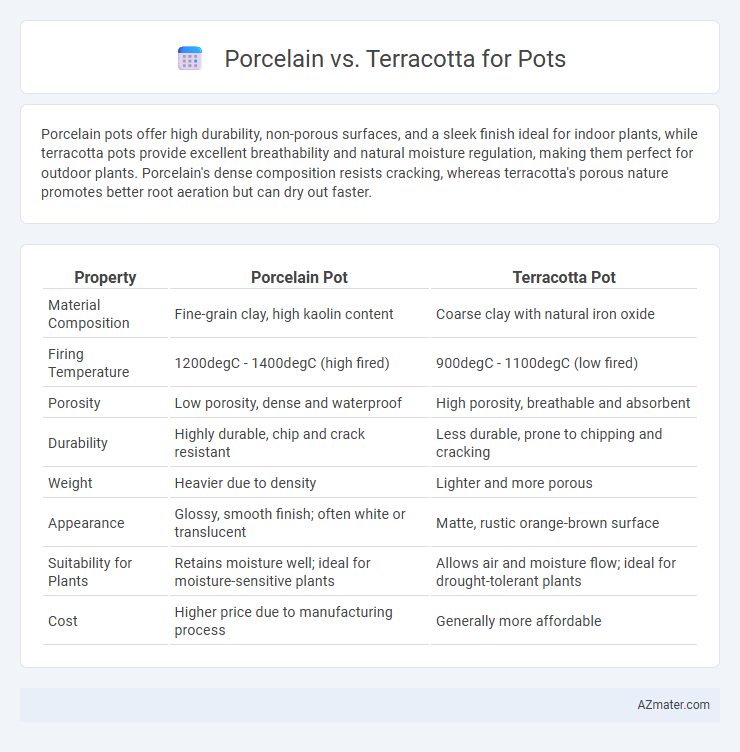Porcelain pots offer high durability, non-porous surfaces, and a sleek finish ideal for indoor plants, while terracotta pots provide excellent breathability and natural moisture regulation, making them perfect for outdoor plants. Porcelain's dense composition resists cracking, whereas terracotta's porous nature promotes better root aeration but can dry out faster.
Table of Comparison
| Property | Porcelain Pot | Terracotta Pot |
|---|---|---|
| Material Composition | Fine-grain clay, high kaolin content | Coarse clay with natural iron oxide |
| Firing Temperature | 1200degC - 1400degC (high fired) | 900degC - 1100degC (low fired) |
| Porosity | Low porosity, dense and waterproof | High porosity, breathable and absorbent |
| Durability | Highly durable, chip and crack resistant | Less durable, prone to chipping and cracking |
| Weight | Heavier due to density | Lighter and more porous |
| Appearance | Glossy, smooth finish; often white or translucent | Matte, rustic orange-brown surface |
| Suitability for Plants | Retains moisture well; ideal for moisture-sensitive plants | Allows air and moisture flow; ideal for drought-tolerant plants |
| Cost | Higher price due to manufacturing process | Generally more affordable |
Introduction to Pot Materials: Porcelain and Terracotta
Porcelain pots are crafted from refined clay fired at high temperatures, resulting in a dense, non-porous surface ideal for retaining moisture and providing durability. Terracotta pots, made from natural clay fired at lower temperatures, feature a porous texture that allows air and water to pass through, promoting healthier root systems. Choosing between porcelain and terracotta depends on factors like plant type, watering frequency, and aesthetic preferences.
Key Characteristics of Porcelain Pots
Porcelain pots are distinguished by their fine, dense, and non-porous structure, offering superior durability and water retention compared to terracotta. Their smooth, vitrified surface resists moisture absorption, reducing the risk of cracking in freezing conditions and making them ideal for indoor and outdoor use. These pots also provide a sleek, often glazed finish that enhances aesthetic appeal while minimizing soil evaporation and promoting healthier plant growth.
Key Characteristics of Terracotta Pots
Terracotta pots are made from natural clay fired at low temperatures, resulting in a porous material that allows air and moisture to penetrate, promoting healthy root growth and preventing overwatering. Their distinctive reddish-brown color and rustic texture provide a classic aesthetic that ages gracefully with time. Terracotta's breathability makes it ideal for plants requiring well-drained soil, though it is more susceptible to cracking in freezing temperatures compared to porcelain pots.
Durability: Porcelain vs Terracotta
Porcelain pots exhibit superior durability compared to terracotta, as their high-density composition makes them resistant to cracking and chipping, even in extreme weather conditions. Terracotta pots, while breathable and lightweight, are more porous and prone to absorbing moisture, leading to potential cracks in freezing temperatures. Choosing porcelain ensures longer-lasting pots with minimal maintenance, especially in outdoor environments subject to temperature fluctuations.
Aesthetics and Visual Appeal Compared
Porcelain pots exhibit a smooth, glossy finish with fine, detailed textures that enhance modern and minimalist aesthetics, while terracotta pots offer a rustic, earthy appeal with their porous, matte surfaces and warm, natural hues. Porcelain's lighter weight and often intricate designs create an elegant visual impact suitable for indoor settings, contrasted by terracotta's sturdy, weathered look favored in garden and outdoor spaces. Both materials provide distinctive visual styles, with porcelain lending a refined, polished look and terracotta contributing a timeless, organic charm.
Water Retention and Breathability
Porcelain pots exhibit low water retention due to their dense, non-porous structure, allowing minimal moisture absorption and maintaining consistent hydration inside the pot. Terracotta pots, made from porous clay, offer high breathability and better moisture evaporation, which prevents waterlogging and promotes root aeration. For plants requiring well-drained soil and frequent watering, terracotta pots are ideal, whereas porcelain pots suit moisture-sensitive plants benefiting from stable water levels.
Suitability for Indoor and Outdoor Use
Porcelain pots offer high durability, low porosity, and resistance to frost, making them ideal for both indoor and outdoor use in varying climates. Terracotta pots, being porous and more susceptible to weathering, are best suited for indoor settings or outdoor areas with mild, dry climates to prevent cracking and moisture damage. For outdoor gardening in regions with freeze-thaw cycles, porcelain provides better longevity, while terracotta enhances aesthetic appeal and breathability indoors.
Plant Health: Which Performs Better?
Porcelain pots are non-porous, offering superior moisture retention and reducing the risk of root dehydration, which benefits sensitive plants requiring consistent watering. Terracotta pots are porous, allowing for better air circulation to the roots and promoting natural evaporation, which helps prevent root rot in drought-tolerant plants. The choice between porcelain and terracotta depends on the plant's water needs and environmental conditions, with terracotta favored for plants needing well-drained soil and porcelain suited for moisture-loving species.
Maintenance and Care Requirements
Porcelain pots require minimal maintenance due to their non-porous surface, which resists moisture absorption and prevents mold growth, making them ideal for indoor plants with low watering needs. Terracotta pots are porous and absorb water, necessitating regular cleaning to avoid salt buildup and cracking, especially in freeze-thaw climates, and they often benefit from sealing to extend their lifespan. Proper care for terracotta includes drying thoroughly after watering and avoiding prolonged exposure to excessive moisture to maintain durability.
Price Comparison and Final Recommendation
Porcelain pots generally cost more than terracotta due to their refined material and manufacturing process, with prices ranging from $20 to $100 compared to terracotta's typical $10 to $40 range. Porcelain is better suited for indoor use due to its durability and smooth finish, while terracotta is favored outdoors for its breathability and natural aesthetic. For budget-conscious gardeners seeking affordable, porous pots for outdoor plants, terracotta is recommended, whereas porcelain serves as a premium choice for decorative, long-lasting indoor planters.

Infographic: Porcelain vs Terracotta for Pot
 azmater.com
azmater.com